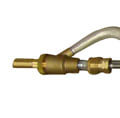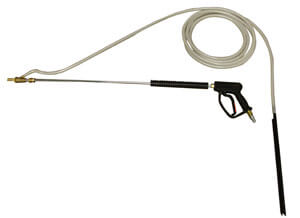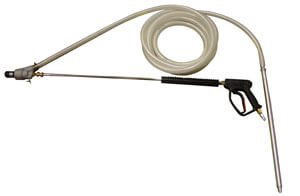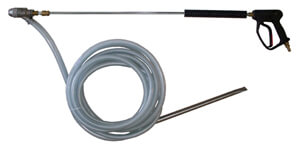Pressure Washer Sand Blaster
Sandblasting Kit General Instructions: Run the sand suction hose on top of the lance. If sand suction hose is under the lance during operation water can run down the sand suction hose getting the sand wet and it will not flow through the head. Eventually the hose will plug and the assembly will need to be cleaned and dried before using. Several pieces of electrical tape can be used to hold the hose in place. Silica sand is recommended.
![]()
Sandblaster Equipment
![]()
Medium-Duty Sand Blasters
Machine use up to 3,500 PSI @ 4.0 GPM. Some assembly required.
Carbide nozzles are more superior to a stainless steel nozzle because they are very long-wearing and extremely corrosion-resistant. Steel or Ceramic Nozzles are suitable for light-duty work or infrequent users.
Features:
- Maximum Pressure 3500 PSI
- Minimum Pressure 2000 PSI
- 20 FT Hose
- Metal Probe
- Sand Blast Head
- Steel Orifice
- Carbide Nozzle
- Nozzle Included (3.0, 3.5, 4.0, 4.5 orifice size can be selected in Shopping Cart)
- Optional: 1/4" Quick Connect Plug - Order Part# 85.300.109 CLICK HERE
| MODEL | DESCRIPTION | PRICE |
| 16.02 | Medium Duty Sandblaster Kit | $156.95 |
| 85.300.109 | 1/4" MPT Plated Steel QC Plug | $5.40 |
![]() Sand Blaster User Manual (184 KB)
Sand Blaster User Manual (184 KB)
Heavy-Duty Sand Blasters 
Machine use up to 5000 PSI @ 8.0 GPM. Some assembly required.
Carbide nozzles are more superior to a stainless steel nozzle because they are very long-wearing and extremely corrosion-resistant. Steel or Ceramic Nozzles are suitable for light-duty work or infrequent users.
Features:
- Maximum Pressure 5000 PSI
- Minimum Pressure 3000 PSI
- Maximum Temperature 195°F
- Minimum Flow 4 GPM
- 25 FT of 3/4" Sand Hose
- Metal Probe
- Adjustable Sand Intake
- Sand Blast Head
- 1/4" Quick Connect Plug and Hose Clamp
- Steel Orifice 4.0
- Carbide Nozzle
| MODEL | DESCRIPTION | PRICE |
| 9001-9-K | 5000 PSI - Heavy Duty Sandblaster | $179.00 |
| UW12-PW6C67 | Replacement Carbide Nozzle | $146.00 |
![]() Parts Breakdown/Usage Instructions (2.42 MB)
Parts Breakdown/Usage Instructions (2.42 MB)
![]()
Industrial Sand Blasters
Machine use from 3000 PSI ( min) to 7250 PSI (max). 4.0 GPM (min) to 8 GPM (max). Fan spray, industrial sandblasting kit, sandblasting nozzle with sand probe, carbide tip. Some assembly required.
Features:
- 25' Sand Hose
- Metal Probe
- Adjustable Sand Intake
- Sand Blast Head
- 1/4" F outlet for 5° - 10° MEG nozzle
- Includes 4-IMEG nozzles, 5° spray angle, sizes 3.0, 4.0, 5.0 and 6.0
- Carbide Nozzle
| MODEL | DESCRIPTION | PRICE |
| AL-TPS450KIT | 7250 PSI - Industrial Sandblaster | $639.80 |
| NZ1003 | 10° Spray Angle, 3.0 Orifice Nozzle | $19.60 |
| NZ1004 | 10° Spray Angle, 4.0 Orifice Nozzle | $19.60 |
| NZ1005 | 10° Spray Angle, 5.0 Orifice Nozzle | $19.60 |
| NZ1006 | 10° Spray Angle, 6.0 Orifice Nozzle | $19.60 |
![]() Professional Sand Blasting Heads (144 KB)
Professional Sand Blasting Heads (144 KB)
Clear Tubing - Reinforced
Machine use from 3000 PSI ( min) to 7250 PSI (max). 4.0 GPM (min) to 8 GPM (max). Fan spray, industrial sandblasting kit, sandblasting nozzle with sand probe, carbide tip. Some assembly required.
Features:
- Reinforced with Polyester Cord
- Huge Selection of Sizes and Lengths
- 4 to 1 Burst Safety Factor
| MODEL | DESCRIPTION | INNER DIAMETER x OUTER DIAMETER | PRICE |
| 8.901-256.0 | 25FT Clear Reinforced Tubing | 1/4" x 3/8" | $18.80 |
| 8.901-257.0 | 50FT Clear Reinforced Tubing | 1/4" x 3/8" | $34.45 |
| 8.704-751.0 | 100FT Clear Reinforced Tubing | 1/4" x 3/8" | $57.00 |
| 8.704-752.0 | 300FT Clear Reinforced Tubing | 1/4" x 3/8" | $145.95 |
| 8.901-260.0 | 25FT Clear Reinforced Tubing | 3/8" x 1/2" | $24.95 |
| 8.901-261.0 | 50FT Clear Reinforced Tubing | 3/8" x 1/2" | $44.15 |
| 8.901-262.0 | 100FT Clear Reinforced Tubing | 3/8" x 1/2" | $68.30 |
| 8.704-753.0 | 300FT Clear Reinforced Tubing | 3/8" x 1/2" | $197.75 |
| 8.901-264.0 | 25FT Clear Reinforced Tubing | 1/2" x 3/4" | $47.00 |
| 8.901-265.0 | 50FT Clear Reinforced Tubing | 1/2" x 3/4" | $55.95 |
| 8.704-754.0 | 100FT Clear Reinforced Tubing | 1/2" x 3/4" | $100.05 |
| 8.704-755.0 | 300FT Clear Reinforced Tubing | 1/2" x 3/4" | $239.45 |
| 8.901-273.0 | 25FT Clear Reinforced Tubing | 1" x 1 1/4" | $112.45 |
| 8.901-274.0 | 50FT Clear Reinforced Tubing | 1" x 1 1/4" | $194.95 |
| 8.901-275.0 | 100FT Clear Reinforced Tubing | 1" x 1 1/4" | $332.05 |
| 8.704-759.0 | 300FT Clear Reinforced Tubing | 1" x 1 1/4" | $692.35 |
How to Operate Your Pressure Washer and Sandblaster
WARNING: To reduce the risk of injury, always protect eyes and face with goggles and mask, and hands and arms with heavy work gloves when spraying abrasive materials.
Place the sand blaster induction probe in the sand supply container.
How To Sandblast :
- Connect and open the water supply line before starting the pressure washer.
- Trigger the gun to relieve the air in the equipment.
- Start the pressure washer. See its instruction manual.
- Trigger the gun to activate the spray.
CAUTION: Always test spray on a scrap of similar material first! The high pressure spray could damage the surface if the sandblaster is held too close. See step 5 below.
- To check the distance you will need to hold the spray nozzle from the surface, start to spray at the scrap of material from a distance of several feet. Gradually move closer, checking frequently to see if the high pressure spray is damaging the surface.
- See the application below for the type of sand recommended for your work surface.
Always point the nozzle downward when not spraying. This prevents water from entering the sand supply. If water does get into the sand supply hose, remove the probe from the sand, hold the gun trigger open, and let the hose air dry. Always be sure the sand hose is dry before using.
Keep the sand covered to prevent the overs pray from wetting the sand. Do not allow small pieces of the sand bag to fall into the sand supply. A smaller piece could prevent the flow of sand.
How to Operate Your Pressure Washer and Sandblaster
Paint Removal
Read about paint removal with a pressure washer and sandblaster attachment.
Sand Mesh: sand mesh refers to the size of sieve through which a particular grade of sand will pass. A "16/50" mesh means that normally, most of these particles will pass through a No. 16 sieve and a very small percentage will pass through a No. 50 sieve.
Note: A No. 16 sieve is a mesh that has 16, 0.046 sq. in. (1.19mm) openings per inch.
Round Sand: this refers to the round edge of the grain of sand. River is a good example of sand worn to its size by water.
Angular Sand: this refers to the grain of sand which have triangular-shaped edges. Crushed rock or sand is usually this type.
Blasting Angle and Distance: this blasting angle can affect the nozzle distance. Always maintain the recommended blasting angle and the proper distance from your work surface for the best sandblasting performance.
| Removal Of: | Sand Mesh | Sand Type | Blasting Angle |
|---|---|---|---|
| Paint from Metal | 20/40 | Round Silica | 0-30 |
| Paint from Masonry | 20/40 | Round Silica | 0-20 |
| Rubber Base Paint from Masonry | 10/35 | Angular | 0-15 |
| Paint from Wood (coarse, rough cut effect) | 40/60 | Round | 1-10 |
| Paint from Wood (smoother, driftwood effect) | 20/40 | Round | 1-10 |
| Metal Scale | 20/40 | Round | 0-15 |
| Rust | 16/50 | Angular | 0-25 |
Adjustable Sand Intake
To increase sand intake, loosen the valve. To decrease sand intake, tighten the valve. By experimenting with different settings, you can determine which setting is most economical for the job. See below for approximate sand usage per minute at each setting.
| Setting Number | Hole Diameter | Sand Injection Rate (pounds per minute) |
|---|---|---|
| 1 | None | 14 |
| 2 | 3/16" | 7 |
| 3 | 1/4" | 4.2 |
| 4 | 5/16" | 3.6 |
To learn more about sandblasting click here.
| Alternate Media for Pressure Cleaning | |
|---|---|
| Sodium bicarbonate (soda) | PRO: Softer than sand or shells. Shatters into dust on impact. If water is used in combination with soda, it can be rinsed into drainage systems as non-toxic residue. CON: Not designed for repeated use as some surface damage may result. |
| Silica sand: Recycled crushed glass | PRO: Readily available. Effective. Affordable. CON: Can be variable in size/coarseness and be very abrasive. |
| Ground pecan or walnut shells | PRO: Softer than sand and less abrasive to walls and structures. Shatters into fine dust on impact, minimizing surface damage. CON: Higher cost-per-pound and reduced speed of clean up. |
| Dry ice | PRO: Discharged via an air delivery system, disintegrates on impact. Both the defacement of paint residue and the dry ice are shattered, with the dry ice returning to the atmosphere, and the paint pulverized to a size that is undetectable around the work vicinity. Comes in variety of sizes for different applications. CON: Costs are higher than the traditional blasting methods. |
| Other options: Ground corn cobs, rubber, carbon flint, gemstones | PRO: New media are in development. CON: May be more expensive. Unproven for some applications. |
Credit to Cleaner Times
Troubleshooting Chart for Sandblasters
| Problem | Problem Cause | Sand Type |
| No Sand | Plugged sand probe | Clear obstruction and make sure air vents in sand probe are open |
| Plugged gun | Remove mixing nozzle and inspect mixing chamber | |
| Wet sand | Dry or replace sand | |
| Low vacuum | Valve open; air leaks in system. Tighten nose clamps | |
| Not enough sand | Incorrect water nozzle | Change spray angle |
| Collapsed hose | Replace hose or remove restriction | |
| Partial obstruction to sand probe | Clear rocks or paper from sand probe inlet | |
| Low sand level | Change probe to new bag of sand | |
| Low water pressure and?or flow rate | See troubleshooting chart in pressure washer instruction manual |
See Also
Use Sandblasting Equipment to Remove Graffiti
Tips and safety practices when using a sandblaster to remove graffiti.











